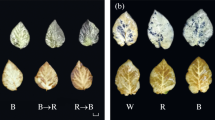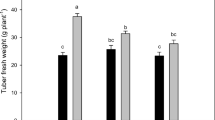Abstract
Artificial light application is an effective method for promoting potato production in indoor facilities. In this study, we assessed the effects of different combinations of red (R) and blue (B) light application on potato leaf and tuber growth. Potato plantlets were transplanted under W (white light, control), RB5–5 (50% R + 50% B), RB3–7 (30% R + 70% B to 70% R + 30% B) and RB1–9 (10% R + 90% B to 90% R + 10% B), and ascorbic acid (AsA) metabolism in leaves and cytokinin (CTK), auxin (indole-3-acetic acid, IAA), abscisic acid (ABA), and gibberellin (GA) levels in tubers were measured. At 50 days of treatment, potato leaves had significantly higher L-galactono-1,4-lactone dehydrogenase (GalLDH) activity and utilized AsA faster under RB1–9 treatment than under RB3–7 treatment. CTK/IAA and ABA/GA ratios in large tubers under W treatment did not differ significantly from those under RB1–9 treatment, which had higher levels than those under RB5–5 and RB3–7 treatment at 50 days. However, under RB1–9 treatment, total leaf area decreased rapidly from 60 to 75 days compared with plants under RB3–7 treatment. Tuber dry weight per plant under W and RB5–5 treatment approached a plateau at 75 days. At 80 days, RB3–7 treatment significantly improved ascorbate peroxidase, monodehydroascorbate reductase, dehydroascorbate reductase, and glutathione reductase activity compared with RB1–9 treatment. RB1–9 treatment with a high ratio of blue light increased CTK/IAA and ABA/GA to improve tuber bulking at 50 days, while RB3–7 treatment with a high ratio of red light stimulated AsA metabolic pathway to delay leaf oxidation and maintain tuber biomass accumulation at 80 days. For the indoor potato cultivation, RB3–7 treatment had a higher proportion of medium-sized tubers, thus being a suitable light treatment.





Similar content being viewed by others
References
Aalifar M, Aliniaeifard S, Arab M, Mehrjerdi MZ, Serek M (2020) Blue light postpones senescence of carnation flowers through regulation of ethylene and abscisic acid pathway-related genes. Plant Physiol Bioch 151:103–112. https://doi.org/10.1016/j.plaphy.2020.03.018
Aksenova NP, Konatantinova TN, Golyanovskaya SA, Sergeeva LI, Romanov GA (2012) Hormonal regulation of tuber formation in potato. Russ J Plant Physiol 59(4):451–466. https://doi.org/10.1134/S1021443712040024
Aksenova NP, Sergeeva LI, Kolachevskaya OO, Romanov GA (2014) Hormonal regulation of tuber formation in potato. In: Ramavat K, Mérillon J (eds) Bulbous plants: biotechnology. Taylor & Francis Group, Boca Raton, pp 3–36
Chen LL, Wang HY, Gong XC, Zeng ZH, Xue XZ, Hu YG (2021) Transcriptome analysis reveals effects of red and blue light-emitting diodes (LEDs) on the growth, chlorophyll fluorescence and endogenous plant hormones of potato (Solanum tuberosum L.) plantlets cultured in vitro. J Integr Agr 20(11):2914–2931. https://doi.org/10.1016/S2095-3119(20)63393-7
FAO (2018) Retrieved from http://www.fao.org/faostat/en/#compare 18 June 2020
Gallie DR (2013) The role of L-ascorbic acid recycling in responding to environmental stress and in promoting plant growth. J Exp Bot 64:433–443. https://doi.org/10.1093/jxb/ers330
Gest N, Garchery C, Gautier H, Jimenez A, Stevens R (2013) Light-dependent regulation of ascorbate in tomato by a monodehydroascorbate reductase localized in peroxisomes and the cytosol. Plant Biotechnol J 11:344–354. https://doi.org/10.1111/pbi.12020
Guo X, Xue X, Chen L, Li J, Wang Z, Zhang Y (2022) Effects of LEDs light spectra on the growth, yield, and quality of winter wheat (Triticum aestivum L.) cultured in plant factory. J Plant Growth Regul. https://doi.org/10.1007/s00344-022-10724-z
He W, Miao C, You J, Gan L, Xu ZG (2020) Effects of red and blue light with supplemental white light on growth, carbohydrate metabolism, and yield of virus-free potato in plant factories. Am J Potato Res 97(6):554–564. https://doi.org/10.1007/s12230-020-09803-2
He W, Pu M, Li J, Xu ZG, Gan L (2021) Potato tuber growth and yield under red and blue LEDs in plant factories. J Plant Growth Regul 41(1):40–51. https://doi.org/10.1007/s00344-020-10277-z
Hosseini A, Mehrjerdi MZ, Aliniaeifard S, Seif M (2019) Photosynthetic and growth responses of green and purple basil plants under different spectral compositions. Physiol Mol Biol Pla 25(3):741–752. https://doi.org/10.1007/s12298-019-00647-7
Jin S, Ding Z, Xie J (2021) Study of postharvest quality and antioxidant capacity of freshly cut amaranth after blue LED light treatment. Plants-Basel 10(8):1614. https://doi.org/10.3390/plants10081614
Kang CH, Yoon EK, Muthusamy M, Kim JA, Jeong MJ, Lee SI (2020) Blue LED light irradiation enhances L-ascorbic acid content while reducing reactive oxygen species accumulation in Chinese cabbage seedlings. Sci Hortic 261:108924. https://doi.org/10.1016/j.scienta.2019.108924
Kim YJ, Kim YB, Li X, Choi SR, Park S, Park JS, Lim YP, Park SU (2015) Accumulation of phenylpropanoids by white, blue, and red light irradiation and their organ-specific distribution in Chines cabbage (Brassica rapa ssp. pekinensis). J Agric Food Chem 63:6772–6778. https://doi.org/10.1021/acs.jafc.5b02086
Kolachevskaya OO, Lomin SN, Arkhipov DV, Romanov GA (2019) Auxins in potato: molecular aspects and emerging roles in tuber formation and stress resistance. Plant Cell Rep 38(6):681–698. https://doi.org/10.1007/s00299-019-02395-0
Leterrier M, Corpas F, Barroso J, Sandalio L, Del Rio L (2005) Peroxisomal monodehydroascorbate reductase. Genomic clone characterization and functional analysis under environmental stress conditions. Plant Physiol 138:2111–2123. https://doi.org/10.1104/pp.105.066225
Li Y, Liu ZL, Shi QH, Yang FJ, Wei M (2021) Mixed red and blue light promotes tomato seedlings growth by influencing leaf anatomy, photosynthesis, CO2 assimilation and endogenous hormones. Sci Hortic 290:110500. https://doi.org/10.1016/j.scienta.2021.110500
Li F, Wu Q, Liao B, Yu K, Huo Y, Meng L, Wang S, Wang B, Du M, Tian X, Li Z (2022) Thidiazuron promotes leaf abscission by regulating the crosstalk complexities between ethylene, auxin, and cytokinin in cotton. Cotton. Int J Mol Sci 2022(23):2696. https://doi.org/10.3390/ijms23052696
Lin K, Huang M, Huang W, Msu M, Yang C (2013) The effects of red, blue, and white light-emitting diodes on the growth, development, and edible quality of hydroponically grown lettuce (Lactuca sativa L. var. capitata). Sci Hortic 150:86–91. https://doi.org/10.1016/j.scienta.2012.10.002
Morris WL, Taylor MA (2010) Tuber development. Plant developmental biology-biotechnological perspectives. Springer, Berlin, Heidelberg, pp 137–150
Ntagkas N, Woltering EJ, Marcelis LFM (2018) Light regulates ascorbate in plants: an integrated view on physiology and biochemistry. Environ Exp Bot 147:271–280. https://doi.org/10.1016/j.envexpbot.2017.10.009
Ntagkas N, Woltering E, Nicole C, Labrie C, Marcelis LFM (2019) Light regulation of vitamin C in tomato fruit is mediated through photosynthesis. Environ Exp Bot 158:180–188. https://doi.org/10.1016/j.envexpbot.2018.12.002
Pandey S, Fartyal D, Agarwal A, Shukla T, James D, Kaul T, Negi YK, Arora S, Reddy MK (2017) Abiotic stress tolerance in plants: myriad roles of ascorbate peroxidase. Front Plant Sci 8:581. https://doi.org/10.3389/fpls.2017.00581
Raspor M, Motyka V, Ninković S, Dobrev PI, Malbeck J, Ćosić T, Cingel A, Savić J, Tadić V, Dragićević IČ (2020) Endogenous levels of cytokinins, indole-3-acetic acid and abscisic acid in in vitro grown potato: a contribution to potato hormonomics. Sci Rep UK 10:1–3. https://doi.org/10.1038/s41598-020-60412-9
Rebeille F, Douce R (2011) Biosynthesis of vitamins in plants Part B. Advances in botanical research, vol 59. Elsevier, Amsterdam, pp 107–177
Roumeliotis E, Kloosterman B, Oortwijn M, Kohlen W, Bouwmeester HJ, Visser RG, Bachem CW (2012a) The effects of auxin and strigolactones on tuber initiation and stolon architecture in potato. J Exp Bot 63(12):4539–4547. https://doi.org/10.1093/jxb/ers132
Roumeliotis E, Visser RGF, Bachem CWB (2012b) A crosstalk of auxin and GA during tuber development. Plant Signal Behav 7(10):1360–1363. https://doi.org/10.4161/psb.21515
Samuoliene G, Sirtautas R, Brazaityte A, Duchovskis P (2012) LED lighting and seasonality effects antioxidant properties of baby leaf lettuce. Food Chem 134(3):1494–1499. https://doi.org/10.1016/j.foodchem.2012.03.061
Santin M, Ranieri A, Castagna A (2021) Anything new under the sun? An update on modulation of bioactive compounds by different wavelengths in agricultural plants. Plants 10:1485. https://doi.org/10.3390/plants10071485
Shao M, Liu W, Zhou C, Wang Q, Li B (2022) Alternation of temporally overlapped red and blue light under continuous irradiation affected yield, antioxidant capacity and nutritional quality of purple-leaf lettuce. Sci Hortic 295:110864. https://doi.org/10.1016/j.scienta.2021.110864
Song Y, Qiu K, Gao J, Kuai B (2020) Molecular and physiological analyses of the effects of red and blue LED light irradiation on postharvest senescence of pak choi. Postharvest Biol Tec 164:111155. https://doi.org/10.1016/j.postharvbio.2020.111155
Torres CA, Andrews PK, Davies NM (2006) Physiological and biochemical responses of fruit exocarp of tomato (Lycopersicon esculentum Mill.) mutants to natural photo-oxidative conditions. J Exp Bot 57(9):1933–1947. https://doi.org/10.1093/jxb/erj136
Xu X, Vermeer E, Vreugdenhil D, van Lammeren AA (1998) The role of gibberellin, abscisic acid, and sucrose in the regulation of potato tuber formation in vitro. Plant Physiol 117(2):575–584. https://doi.org/10.1104/pp.117.2.575
Zha LY, Liu WK, Yang QC, Zhang YB, Zhou CB, Shao MJ (2020) Regulation of ascorbate accumulation and metabolism in lettuce by the red: blue ratio of continuous light using LEDs. Front Plant Sci. https://doi.org/10.3389/fpls.2020.00704
Zhou C, Shao M, Liu W, Li B, Wang Q, Liu J, Wen Y, Yang Q (2021) Regulation of ascorbate accumulation and metabolism in lettuce by end-of-production high light irradiation provided by red and blue LEDs. Environ Exp Bot 189:104567. https://doi.org/10.1016/j.envexpbot.2021.104567
Zhou H, Beynon-Davies R, Carslaw N, Dodd IC, Ashworth K (2022) Yield, resource use efficiency or flavour: trade-offs of varying blue-to-red lighting ratio in urban plant factories. Sci Hortic 295:11802. https://doi.org/10.1016/j.scienta.2021.110802
Acknowledgements
This research was supported by Gansu Province Science Foundation for Youths (21JR7RA841), GAU-KYQD-2020-16, and Key talent project of Gansu Province.
Author information
Authors and Affiliations
Corresponding author
Ethics declarations
Conflict of interest
The authors declare no conflicts of interest for this research.
Additional information
Publisher's Note
Springer Nature remains neutral with regard to jurisdictional claims in published maps and institutional affiliations.
Rights and permissions
Springer Nature or its licensor (e.g. a society or other partner) holds exclusive rights to this article under a publishing agreement with the author(s) or other rightsholder(s); author self-archiving of the accepted manuscript version of this article is solely governed by the terms of such publishing agreement and applicable law.
About this article
Cite this article
He, W., Chai, Q., Zhang, D. et al. Beneficial effects of red and blue light on potato leaf antioxidant capacity and tuber bulking. Physiol Mol Biol Plants 29, 513–523 (2023). https://doi.org/10.1007/s12298-023-01309-5
Received:
Revised:
Accepted:
Published:
Issue Date:
DOI: https://doi.org/10.1007/s12298-023-01309-5




